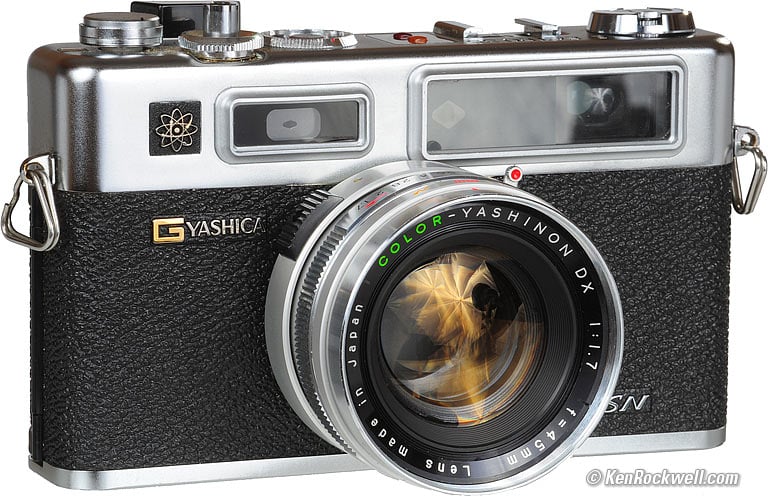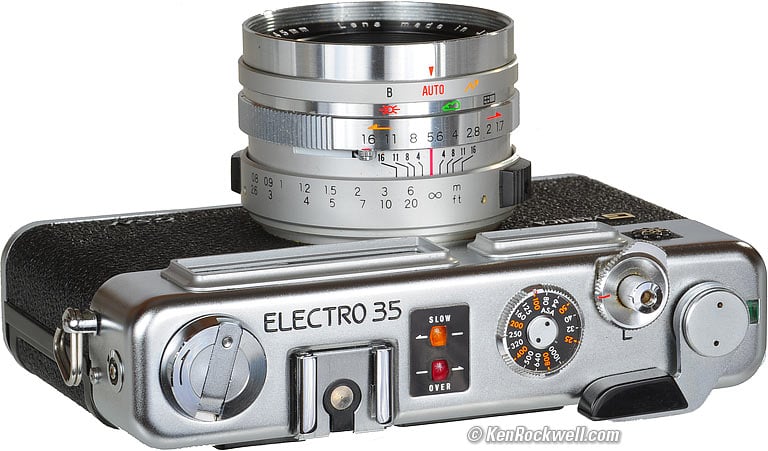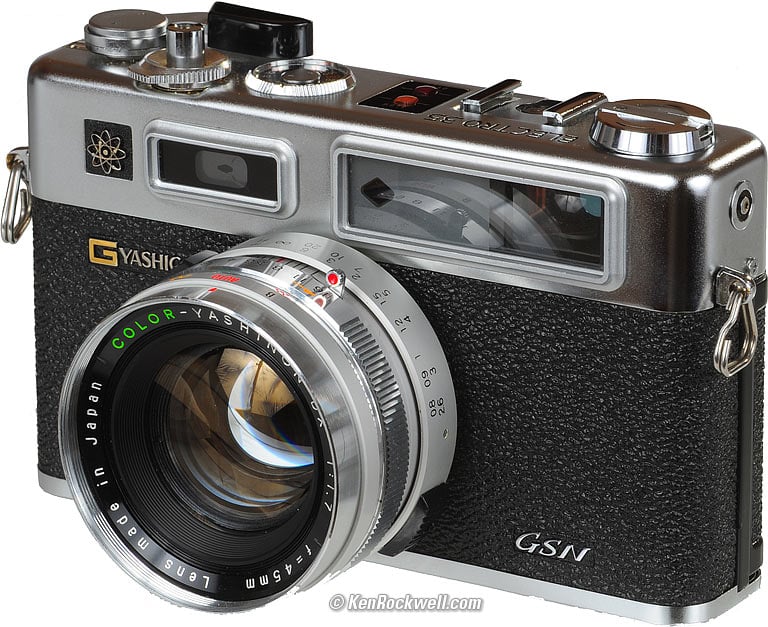Home Donate New Search Gallery Reviews How-To Books Links Workshops About Contact
Yashica Electro 35
(1966-1977; GSN: 1971-1977)
© 2008 KenRockwell.com. All rights reserved.
Yashica Electro 35 GSN. enlarge. This free website's biggest source of support is when you use these links, especially this link directly to them at eBay, (see How to Win at eBay), and maybe at at Adorama. It helps me keep reviewing these oldies when you get yours through these links, thanks! Ken.
September 2011, June 2008 Yashica Reviews All Reviews
Sample Images from 15 September 2008
Not great, but not awful from one 24-exposure roll of throw-away film for a first try:
|
I buy only from these approved sources. I can't vouch for ads below. |
Intro History Specs Accessories Performance Usage Recommendations
The Yashica Electro 35 was one of the most popular consumer 35mm cameras of the 1960s and 1970s. My grandparents had one. They took it all over the world on their vacations, and came back with loads of great slides.
Everyone's grandparents had one. Yashica sold eight million of these in various versions over 15 years.
The Yashica Electro 35 is a solid metal camera. It has a big, clear viewfinder and rangefinder. It has a much clearer finder than the Nikon manual rangefinders of the 1950s that fetch astronomical prices from geriatric collectors.
The Yashica Electro 35 was designed for consumers, but the great news for serious photographers is that the advanced features it had in 1966 are just what we need, and it doesn't have any of today's junk features that just get in the way.
The Yashica Electro 35 is an aperture-priority camera. Pick your aperture, and the Yashica Electro 35 selects the shutter speed, from 1/500 up to thirty seconds or more!
It has a silent electronic leaf shutter. It's quieter and and has less vibration than any of the clumsier focal-plane shutters of Leica and Nikon rangefinders, and no flipping mirrors like every DSLR.
The only gotchas are that the Electro 35 has no auto-exposure lock and it's an almost all-auto camera. It only has three manual shutter speeds, and that's stretching it. It is designed for a no-longer available mercury battery, however modern alkaline replacements work fine.
This Yashica a solid metal camera. It is a joy to carry around compared to my hulking Nikon D3, but still has to be carried over-the-shoulder.
The Electro 35 has always been inexpensive. In 1977 they sold new for $100, which is $350 corrected for inflation in 2008. In 2008, they sell used for $5 to $20 at garage sales. A dealer will ask more.
It's solid and well-made, but not as precise or as fine as a Leica, or even as nice as the less-useful Nikon rangefinders of the 1950s.
Since you're not looking through the lens, these cameras are especially useful for black-and-white and infra-red photography. This is because even with a dark filter on the lens, the finder remains clear.
History back to top
Intro History Specs Accessories Performance Usage Recommendations
The Yashica Electro 35 was very advanced, being electronic, when it came out in 1966. It was made though 1977, and sold at close-out until stocks ran out about 1980. Please note the space-age atomic symbol on the front. The Yashica Electro is the Apollo of Japanese consumer 35mm cameras. (Of course I'm kidding; Japanese cameras have nothing to do with the Apollo program. The official cameras are Hasselblad and Zeiss, while the Kodak Instamatic 104 was the official camera of the American people of that era.)
The only real differences over the Electro 35's fourteen year run are that the first models lacked a hot shoe and that the ASA ranges changed as films advanced.
Color |
Dates |
ASA (ISO) |
Hot Shoe |
|
| Electro 35 | Chrome |
1966-1968 |
12-500 |
no |
| Electro 35 G | Chrome |
1968-1970 |
12-500 |
no |
| Electro 35 GT | Black |
1969-1970 |
12-500 |
no |
| Electro 35 GT | Black |
1970-1973 |
25-1,000 |
no |
| Electro 35 GS | Chrome |
1970-1973 |
25-1,000 |
no |
| Electro 35 GSN | Chrome |
1973-1977 |
25-1,000 |
Yes |
| Electro 35 GTN | Black |
1973-1977 |
25-1,000 |
Yes |
ASA Range: Film got faster over the years. The only good color film in the 1960s was Kodachrome, which was ASA 10. As of 1970, ASA 10 Kodachrome was long gone but some super-speed films were faster than ASA 500.
Hot Shoe: "Hot" means modern flashes connect automatically as you slide them in. In the old days, people used separate flash guns that used flash bulbs, so hot shoes didn't matter.
Specifications with Commentary back to top
Intro History Specs Accessories Performance Usage Recommendations
Top, Yashica Electro 35 GSN. enlarge.
Lens: 45mm f/1.7. It's identical to an SLR lens. Yashica brands it as YASHINON. "COLOR-YASHINON" was added in 1968 for marketing, since color film was just starting to become barely affordable to amateurs. It's the same lens. "COLOR" was a buzzword of the day as "Digital" is today. Think this is silly? How many of you pay extra for "Digital" filters?
Optic
6 elements in 4 groups, just like almost every SLR lens.
Single-coated in amber.
Diaphragm
5 blades stopping down to f/16.
Filter Thread
55mm. (Optional 57mm slip-on hood.)
Close Focus
2.6 feet (0.8m)
Finder
Always-bright framelines lit through a separate window. Auto corrects for parallax.
Meter
CdS cell above lens, not TTL. You must compensate filters by setting the ASA dial accordingly.
Red OVER light means you're at 1/500 second or more.
Yellow SLOW light means you're at 1/30 or slower; hold still or use a tripod.
ASA Range (ISO)
1966-1973: 12~500.
1973-1977: 25~1,000.
Shutter
1/500 ~ about 30 seconds.
Stepless electronic leaf shutter.
The slowest speed will vary with aperture: it can go longer than a minute at smaller apertures but only 3 seconds at f/1.7.
Maximum Speed with Flash (sync)
1/500.
X-sync at all speeds, better than SLRs.
Power
One PX32, E164, V164PX, TR 164, HM-4N, 4NR52 or 1404M 5.6 Volt mercury battery.
Works with today's alkaline replacements. My Electro 35 has a 4LR52, EN164A, A32, PC164, TR164A, 1404A alkaline in it. These are made with four stacked LR52 or 640A-P cells in series.
The specifications for today's alkaline battery are 335 mAH, 25.5g, 17.1mm diameter, 44.9mm height.
You can use a more common, smaller (170 mAH lithium, 150 mAh alkaline) PX28 if you jam in an extra spring and wrap the smaller battery in something to keep it centered in the Electro 35's larger battery hole.
The correct PX32 costs only $9.99 and lasts twice as long as the wrong $8 PX28 that doesn't fit without a kludge, so order two PX32s and keep the spare handy so you won't have to pay $15 for a PX28 at retail if your battery dies.
Battery Check Light
Yes, also illuminates frame counter and can work as a small flashlight!
Current Drain
60mA while shutter is pressed and lights are lit or shutter is open.
Less than 0.1 uA when idle.
Size
6 x 3-5/8 x 3 " (152 x 92 x 76mm) WHD, measured, including protrusions, excluding cap or case.
Weight
My Electro 35 GSN, made in Hong Kong, measures 25.692 oz (728.4 g) with full-size alkaline battery, but no case, filters, caps or strap.
Yashica specifies 26.4 oz (750 g) without battery, which is heavier than mine.
Made in
Japan, or later, Hong Kong.
The lenses always say "Lens Made in Japan" even if the camera is made in Hong Kong. Hong Kong is discretely stamped on the bottom.
Accessories back to top
Intro History Specs Accessories Performance Usage Recommendations
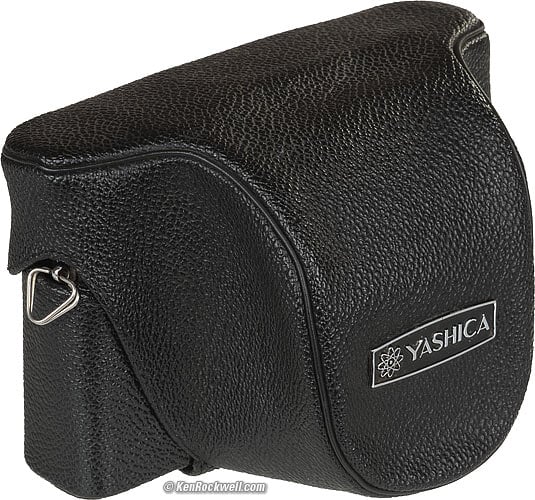
Yashica Electro 35 GSN in never-ready case.
Wide and Tele Lenses
Forget these. These were bogus "goggles" that screwed on the front of the fixed lens, and only made things worse.
These were awful because:
1.) They didn't really do anything to change the focal length. The "tele" was only 58.4mm and the "wide" only 37.7mm!
2.) Focus was a pain. They required several manual steps of measuring the subject distance with the rangefinder, referring to a table and then resetting the rangefinder — for each shot!
3.) You had to compose through a separate finder which sat in the flash shoe, making you inable to use a conventional flash at the same time.
4.) I think exposure was also screwed, with potentially weird restrictions and recalculations of the widest apertures.
Close-Up System
Yashica offered the usual close-up lens and prism system. It lets you shoot from 18 to 32 inches (45~80cm).
It is a close-up lens, and a prism which covers the viewfinder and rangefinder.
Yashica, using proper Japanese English, called this the "Auto-Up Lens."
ST-7 Dedicated Mini-Tripod
This is an 8" (20cm) thing. The bottom screw of the camera case has cut-outs which the users manual champions as being uniquely dedicated to some nubbins on the tripod legs.
This pocket tripod was nothing special, but the Electro 35's low-light capability is. You owe it to yourself to carry a pocket tripod for night shots.
MS-20DX Flash
Yashica heralded this as "The Worlds Smallest" flash with GN 20 (meters, ASA 100). That's GN 64 in feet, ISO 100, or one-quarter the rating of the Vivitar 283.
It has a fixed-output (manual exposure - no automation) and uses two AAs.
Yashica claimed that it was good for up to 40 shots on one set of batteries, type unmentioned in the 1970s.
You much calculate the aperture by dividing the guide number by the subject distance, and setting that on the aperture ring.
You can safely ignore this flash. Far more useful is any flash with an AUTO setting.
Performance back to top
Intro History Specs Accessories Performance Usage Recommendations
The Yashica Electro 35 GSN. enlarge.
Overall
It's a good camera. It does what you need it to, and nothing more. The lens is fast and sharp.
It's fun, easy to use and gives great results. It doesn't have any pointless features to get in the way.
The only serious shortcoming is the lack of an auto exposure lock or meaningful manual settings. This means the only way to compensate for backlight or bright or dark subjects is to tweak the ASA dial.
Ergonomics
The Yashica Electro 35 is easy to use. Nothing gets in the way, so long as you don't need AE lock. This lack of fluff just lets me shoot and concentrate on my composition. Not worrying about anything else, like AF tracking or histograms, lets me concentrate on what matters: the picture.
The distance scales are both in black, which always makes it confusing trying to figure which is meters and which is feet.
The red and yellow OVER and SLOW indicators are all I need, and the colors and in-finder arrow directions are just perfect.
Rangefinder
The rangefinder is bright, sharp and contrasty.
My shots are always in focus, even at f/1.7.
Lens
The lens has the same performance as any other fast normal SLR lens.
45mm is dead normal on 35mm film. 50mm lenses are actually a bit longer than normal, even if they are more common. A "normal" lens is defined as having a focal length equal to the film diagonal, which is 43.2mm on 35mm film. Thus anything from 40mm to 45mm is normal, with 35mm lenses being a bit wide and 50mm lenses being a bit narrow.
Sharpness
Just like all other fast normal SLR lenses, it's sharper than most people will ever be able to realize unless they are printing many feet (meters) wide.
It's a little softer in the far corners wide open, and much better by f/2.8. This is as expected.
Coma
Coma is when bright points of light become blobs in the corners at night.
As expected, there is some minor coma wide-open, which is gone by f/2.8.
Distortion
As most other fast normal lenses, there is just a tiny bit of barrel distortion.
It is not visible unless you look for it deliberately.
If you do, dial-in +1.00 in Photoshop CS2's lens distortion filter to rectify it.
Metering
Metering is lower center weighted.
The metering system is live and measures the light during the actual exposure. An integrator counts off the photons while the shutter is open, so if the light changes during an exposure, the Yashica Electro 35 compensates on the fly.
CdS cells don't respond to light very quickly, so this doesn't mean much except for time exposures. If the lights suddenly come up, the Electro 35 will cut a time exposure short to correct for it.
It works great for negative film. I haven't tried it jet with Velvia slides.
Meter and Shutter Range
Overall
The system changes ASA (ISO) with a window in front of the CdS cell. Electronically, the Yashica Electro 35 GSN has no idea of the film speed. The metering range remains constant in terms of exposure value (EV). The light values (LV) covered by the system vary with film speed.
Bright Light
The shortest exposure is 1/500. I'm curious if the metering system somehow can't muster 1/500 when stopped down, since Yashica suggests an ND filter for beach and direct sunlight. I've had no problems with ISO 200 print film in the direct California sun.
If and only if the Yashica Electro 35 can get to 1/500 at f/16, that means the brightest EV covered is LV 17, perfect even for ISO 400 slide film in direct sunlight.
In the Dark
As tested, my sample Electro 35 GSN runs a maximum of about 3 seconds at f/1.7.
The electronics calculate time electronically as the lens is stopped down. The maximum time increases directly at smaller apertures to maintain the same total exposure.
Aperture |
Longest Exposure |
f/1.7 |
3 sec. |
f/2 |
4 sec. |
f/2.8 |
8 sec. |
f/4 |
15 sec. |
f/5.6 |
30 sec. |
f/8 |
1 minute |
f/11 |
2 minutes |
f/16 |
4 minutes |
These all are equivalent to LV 0, which is a few stops short of being able to shoot under moonlight, but more than enough for dark city streets at night.
Manual Exposures
The aperture is always set manually. That's the easy part.
You're on your own for the shutter. The only real manual speed is the flash position, which is 1/30.
Let's be generous and consider Bulb as another manual speed.
Take out the battery, and the Electro 35 free runs at about 1/500.
Want manual exposure? You want a Canonet GIII QL-17.
Usage back to top
Intro History Specs Accessories Performance Usage Recommendations
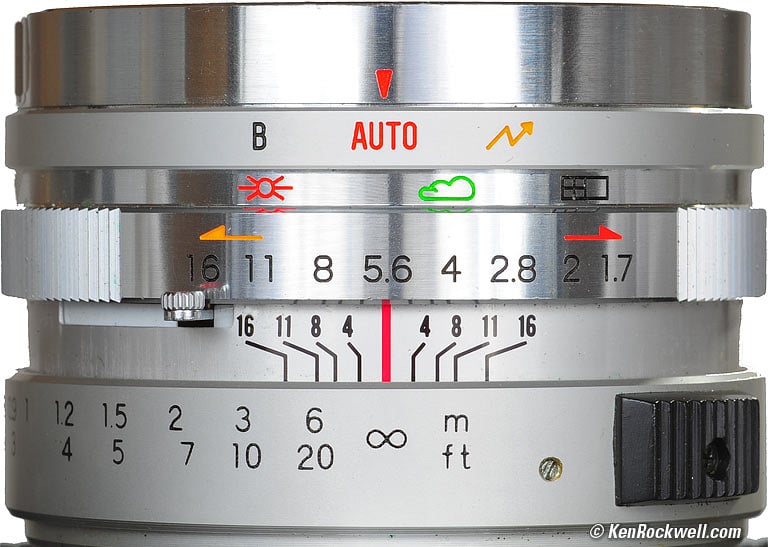
Yashica Electro 35 lens and controls.
General
It's easy for any photographer to figure out. Press the Battery Check button, and the frame counter should light brightly in green. Green means GO, so load your film, wind to frame one, pick an aperture, focus, compose and shoot.
The red OVER and yellow SLOW lights are visible on the top of the camera for tripod use, and also appear as arrows in the finder. If you see the red OVER light, turn the aperture ring in the same direction to make the light go out.
If you see the yellow SLOW light, you'll get the correct exposure, but will need a tripod or a rock to insure a blur-free shot.
The lights, if they are to appear, will appear one-by-one as you press the long-travel shutter button. First the red appears, and then the yellow.
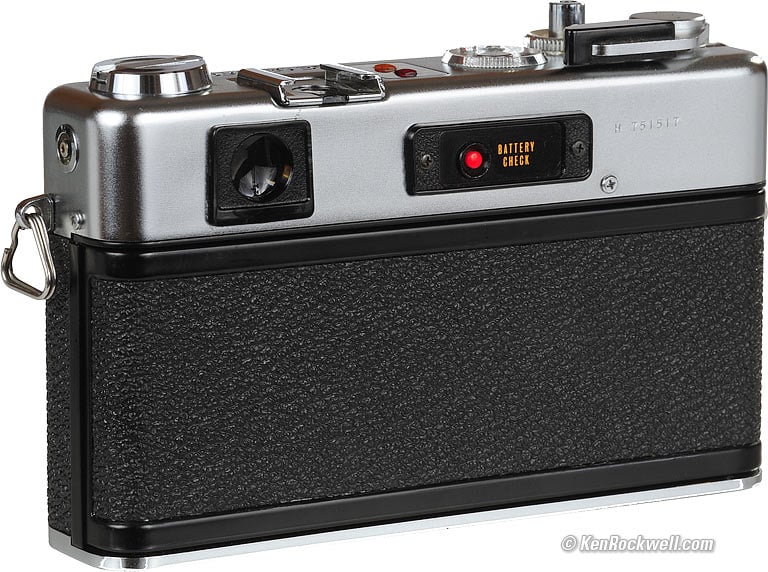
Yashica Electro 35, rear.
Battery-Check Light
The battery-check light lets you see the frame-counter in the dark. It's pretty bright, so you also can use it to find your keys or signal for help on a deserted island!
Use with Filters
The meter doesn't look through the filter. Therefore you must set a lower ASA on the top meter dial to compensate for the light lost by the filter.
Self-Timer
Gently rotate the lens' red-tipped lever (near the finder window) towards the bottom of camera. It buzzes mechanically after you press the shutter.
Shutter Lock
Move the collar around the shutter button to "L" to lock it.
Fill Flash
An advantage of leaf-shutter cameras is that they sync with flash at every speed.
It's easy to get balanced fill flash automatically in any light. Here's how:
1.) Use an "automatic" electronic flash, like the Vivitar 283 or just about anything.
2.) Choose the aperture at which you'd like to shoot and set it on the lens.
3.) Select your fill ratio in stops. (Try one stop for starters.) Set your flash for an aperture this many stops smaller than the lens' setting.
Example: With a Vivitar 283 flash and ISO 100 film, let's decide we want to shoot at f/11. Set the Vivitar 283 to blue, which is f/8 at ASA 100. f/11 is one stop smaller than f/8, so the flash fill will be one-stop less than the ambient exposure. You may or may not also want to set the ASA a little higher to compensate for the slight additional light of the flash.
Yashica's Tips
Don't wind the film to the next frame, which cocks the shutter, if you're putting the camera away. It's best to leave the shutter uncocked. I've discovered that the meter won't activate when the shutter is uncocked; I don't know if this helps save batteries.
To shoot at 1/500 for action, turn the aperture ring until the red arrow just goes out.
To compensate the meter since there is no AE Lock, set an ASA one or two stops slower to lighten backlit shots. Since it's an averaging meter, if the frame subject is mostly dark with a smaller subject in the center, set the ASA one or two stops higher.
Yashica suggests an ND filter in bright light. I'm unsure why, unless the meter and shutter range is somehow restricted at small apertures.
Recommendations back to top
Intro History Specs Accessories Performance Usage Recommendations
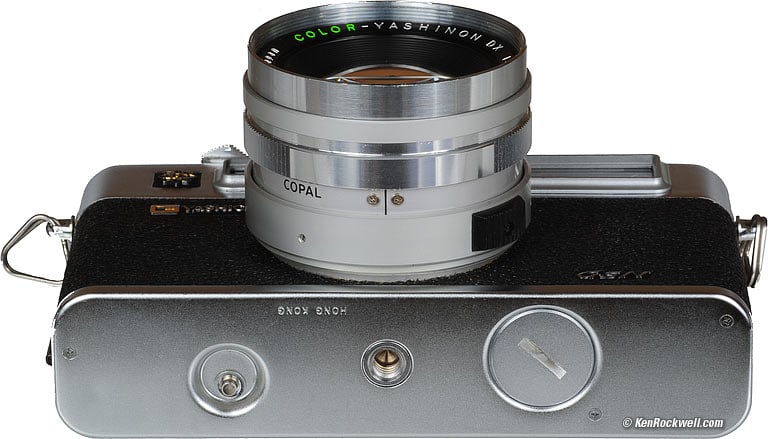
Bottom, Yashica Electro 35 GSN. Lettering on bottom says "HONG KONG," upside down.
Got garage sales? Got ten bucks? Want a sharp lens? Get one of these Yashica Electro 35s, preferably the newest GSN model, for its hot shoe.
If you're a serious rangefinder film shooter, this is an easy camera to love, but you'll probably prefer the greater flexibility of the Nikon 35Ti or Konica Hexar.
Warning: Always check for your lens cap. We paint ours day-glo orange as a safety precaution. If you go out with your cap attached, you can shoot dozens of rolls before you might realize it's on. The meter, viewfinder and everything except picture taking work perfectly even with the cap on.
To see an original ad: have a look at Modern Photography magazine, July 1966, page 36
Acknowledgement: Many thanks to Eric in Wisconsin of WorldDirectPromo.com, from whom this camera comes.
Help me help you top
I support my growing family through this website, as crazy as it might seem.
The biggest help is when you use any of these links to Adorama, Amazon, eBay, Ritz, Calumet, J&R and ScanCafe when you get anything, regardless of the country in which you live. It costs you nothing, and is this site's, and thus my family's, biggest source of support. These places have the best prices and service, which is why I've used them since before this website existed. I recommend them all personally.
If you find this page as helpful as a book you might have had to buy or a workshop you may have had to take, feel free to help me continue helping everyone.
If you've gotten your gear through one of my links or helped otherwise, you're family. It's great people like you who allow me to keep adding to this site full-time. Thanks!
If you haven't helped yet, please do, and consider helping me with a gift of $5.00.
As this page is copyrighted and formally registered, it is unlawful to make copies, especially in the form of printouts for personal use. If you wish to make a printout for personal use, you are granted one-time permission only if you PayPal me $5.00 per printout or part thereof. Thank you!
Thanks for reading!
Mr. & Mrs. Ken Rockwell, Ryan and Katie.
Home Donate New Search Gallery Reviews How-To Books Links Workshops About Contact
